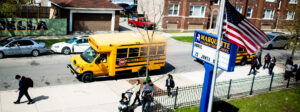Gary Funk is the founding Director of Rural Schools Collaborative, based in Cambridge, Wisconsin. With decades of experience working on education in rural communities, Gary has helped the Rural Schools Collaborative become an influential voice in education. As we at TNTP shape our vision around what successful rural partnerships should look like, Gary has been an invaluable supporter, generously lending us his time and guidance. Recently, we sat down with Gary to get his insights on the complexities and opportunities that exist in our rural communities.
Can you talk about your background in rural education, and how you got involved with Rural Schools Collaborative?
I began as an elementary school teacher in a small Ozarks town. From there, for nearly a decade I worked with several other small towns and rural school districts on literacy issues. I slowly came to see the relationships schools had with their communities were instrumental beyond just student success in the classroom—the community and the school really depended on each other.
When you get down to it, if the purpose of a public school isn't to strengthen the community, why are we doing this? Surely, it's not just about rewarding the ten brightest kids and sending them off packing to an urban area.
At that point, I had an opportunity to head up a public foundation, the Community Foundation of the Ozarks, during a formative time in the organization's history. I had the good fortune of working with an active board and an emerging donor base to recreate the organization in a more Ozarks-centered way. It became evident to us early on that it was important we work to strengthen the bonds between schools and communities as over the past few decades some of the traditional linkages had weakened.
Through some thoughtful planning and hard work by colleagues, and frankly just some dumb luck, we were able to garner a large pool of assets that we geared toward building what we called the Rural Schools Partnership. We centered our work on engaging the community in the curricular process and involving the school in what’s happening in the community. We also did work around community-based philanthropy and included a variety of community groups and partners in discussing education as an economic necessity for rural places—because so much money is leaving our rural communities.
And because of the success we had with this, we began discussing these issues with like-minded people across the country, and then, three years ago, eight or nine of us thought, “Hey, let's go ahead and begin this conversation on a wider level. And we're not going to try to be something we're not. We're not claiming to be some big national organization. We're not going out looking for a zillion dollars. We're just going to begin by working with communities, having a good dialogue, and tackling selected projects that make sense.” And that's the Rural Schools Collaborative.
I'm interested in the comment you made about school to community linkages disappearing. What would you attribute this to?
Three things come to mind. First, the nature of school boards and politics in general has changed. If you look from the 1970s on, trust in the political process and confidence in government has evolved—I think that's a pretty safe statement to make in 2017. And alongside that, the essence of leadership in public education has changed, too. In southern Missouri, I’ve seen school boards become more agenda driven—I think the political process has a lot to do with that.
Also, I think the economics of rural towns has changed as well, and not necessarily in the best ways. Arthur Mallory, who used to be the Missouri Commissioner of Education, said he'd drive into a community in the early 1970s and look at the names on the storefronts and come pretty close to guessing who was on the school board. And while that sort of parochialism may have had its drawbacks, it conveys a strong sense of connectedness and history. And today, almost all those stores have shut down. Many of the children of families that had assets and wealth in small towns have left for places like Minneapolis or Chicago or Nashville or New York City or wherever, and that’s created a void.
Lastly, the way we judge schools has changed, too. Since the 80s, we’ve increasingly relied on high-stakes standardized testing. And frankly, while I think everybody agrees we want students to learn and we want schools to be as healthy as possible and teachers to be as effective as possible, some of these accountability measures are not necessarily relevant when it comes to what goes on in small towns.
These three things, among others I’m sure, have led to a sense of confusion in school districts that’s been detrimental overall and is particularly challenging for rural regions.
I’m curious what examples you’ve seen of schools in rural communities using education as a lever for development and civic engagement, despite facing some of the headwinds you mentioned.
I was just in southern Illinois, way down in southern Illinois, which is more like Kentucky and Tennessee than Chicago—the Little Egypt area. I was in two communities that both have high poverty rates, as well as wonderful diverse populations. One of these towns has a large African-American population, and the other had a large Hispanic population, for two entirely different historical reasons.
And it was evident that, while these two communities were really struggling—one town’s Main Street was basically boarded up—the schools were thriving and healthy and well cared for. And these are very rural towns. I’m talking populations in the hundreds. Our country has scores and scores of places like these—and it's obvious to me that often many of the valuable things happening in these communities revolve around the schools.
We talk about the state of education and the need to improve education, and we talk about rural schools suffering, but the thing is, a lot of these schools are doing really well—some of them against all odds.
Like in Illinois, the state funding situation is tough. Towns are shrinking, there’s no doubt. Many are half the size they used to be, many of the local businesses are gone, and meanwhile, schools are expected to do more and more, and then are judged negatively when they can’t do so.
I’m sure there are things these schools can be doing better, but we really need to start accentuating the assets that we have in public education in rural places and use it as a foundation, if you will, for strengthening these communities and building these communities back up. I think that's one of the best bets we have when it comes to revitalizing rural America.
I know one of the ways Rural Schools Collaborative encourages connectedness between the school and its surrounding community is through place-based education. For readers hearing about it for the first time, can you describe place-based education and talk about why it’s valuable in rural communities?
The key to understanding place-based is recognizing that students are curious about things which have meaning to them—I don't think any learning theorist would disagree with that. The idea is, if you connect learning goals and instruction to things that have relevence to students—and if you can do that in a way that also strengthens the community and engages people from the community in the educational process—the benefits are numerous.
So, when we talk about place-based, we’re talking about learning that's embedded in the community or engages the community. Certainly, there are academic goals and rigorous standards—it's not just sitting under the trees and watching the wind blow, although that might not be all bad—but at the same time, place-based gets kids thinking about where they are and encourages them to get involved in their community.
This does require some creativity, and it does require doing things differently from place to place. But I’ve also seen that it gets teachers fired up and gives them a sense of ownership. We talk a lot about wanting our schools to be entrepreneurial and innovative, but the truth of the matter is, unless it's a special situation, we don't often let schools do that.
Furthermore, for rural students, place-based is particularly relevant because rural schools have some disadvantages if you compare them to their urban counterparts, particularly those in more affluent areas. Internet access issues are a big part of this—because of our inability to figure out how to get broadband to certain parts of the country.
But where rural schools do have an advantage—and we talk about the rural advantage quite a bit—is that access to place should be a little simpler. If you're in the Parkway district in St. Louis and you want to get hither and yon, that becomes a much more bureaucratic endeavor than if you’re in Cambridge, Wisconsin where you can walk out the door of the elementary school, take a two minute walk down an uncrowded street, and there’s a stream right there—a great learning tool for a science class, for example.
So much of the messaging students in rural places get about where they live comes from mass media, and these messages are often condescending—the narratives for their communities are written for them. But place-based allows students and teachers to create their own stories in ways that give students an appreciation for where they live. That doesn't mean every bright kid from Tamms, Illinois is going to want to stay in Tamms, but at the very least they’re learning about what makes their town great, and hopefully a little about why it’s worth preserving.





